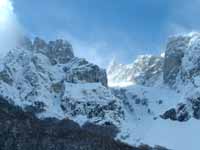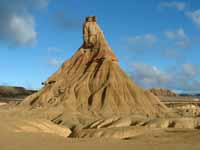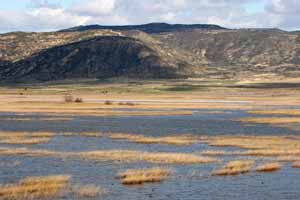All
photographs © 2005 F. S. Simpson
INTRODUCTION
This
short trip report details the birds observed during a long weekend
tour in northern Spain, principally the montane limestone area
of the Liébana Valley in the Picos de Europa (part of the Cordillera
Cantábrica) and the gypsum steppe-like landscape of Las Bardenas
Reales in the Ebro Valley near Pamplona. Originally I had intended to
visit my brother in Galicia and explore some of the Rías on
the Atlantic coast but a change of plan meant I had to reorganise
the trip around some sites within easy reach of Bilbao. All
sites below are within two to three hours drive of the airport.
The region was still in the grip of winter so finding Snow Finch
above Fuente Dé was out of the question due to the heavy snow.
Wallcreeper and the other high altitude species were easy to
find in the Picos as were Sandgrouse in the lowlands but few
Spring migrants were apparent.
HIGHLIGHTS
Black-necked
Grebe · Great Egret · Red-crested Pochard · Red-breasted Merganser
· Egyptian Vulture · Griffon Vulture · Golden Eagle · Red Kite
· Black Kite · Purple Sandpiper · Black-bellied Sandgrouse ·
Pin-tailed Sandgrouse · Black Woodpecker · Middle Spotted Woodpecker
· Thekla Lark · Lesser Short-toed Lark · Dupont's Lark · Crag
Martin · Water Pipit · Alpine Accentor · Black Redstart · Dartford
Warbler · Firecrest · Marsh Tit · Crested Tit · Wallcreeper
· Short-toed Treecreeper · Southern Grey Shrike · Alpine Chough
· Red-billed Chough · Spotless Starling · Rock Sparrow · Rock
Bunting.
LOGISTICS
Flights
from London Stansted to Bilbao cost £45 each and Hertz car hire
cost £125 for a new Ford Focus for the five days. Low season
prices for
the Hotel del Oso in Cosgaya,
Picos de Europa cost about £40 for a twin room per night, and less for hotels in Tudela and Oieregi with no need for advance
booking at this time of year. All
roads were fast and trouble free with the exception of the N-240
between Pamplona and Jaca. The traffic was crawling along due
to the large number of people walking this section of the Camino
de Santiago which appears to be right by the roadside here.
Roads were slow in the Picos at certain times while the ploughs
cleared the falling snow. On some sections of the A-8/E-70 and
E-05/N-1 there was a toll charge (Peaje) of a few euros.
GUIDES, MAPS & TRIP REPORTS
1. Rebane, M. 1999. Where to watch birds in North & East Spain. Helm
2. Svensson, L. et al. 1999. Bird Guide.
HarperCollins.
3. Dubin, M. 2001. The Rough Guide to the Pyrenees. Rough Guides.
4. Road Atlas: Atlas de carreteras de Espana y Portugal. AA/Editorial GeoPlaneta.
ITINERARY
Day 1 03/03/05 London Stansted > Bilbao
> Santander > Potes > Fuente Dé > Cosgaya.
Day 2 04/03/05 Cosgaya
> Potes > La Hermida > Fuente Dé > Cosgaya.
Day 3 05/03/05 Cosgaya
> Bilbao > Vitoria-Gasteiz > Pamplona > Foces de
la Sierra de Leyre > Tudela.
Day 4 06/03/05 Tudela
> Las Bardenas Reales > Laguna de Pitillas > Pamplona
> Oieregi.
Day 5 07/03/05 Oieregi
> Parque Natural de Bértiz > Reserva de la Biosfera de
Urdaibai > Bilbao.
THE DIARY
Thursday 3
March 2005
London Stansted > Bilbao
> Santander > Potes > Fuente Dé > Cosgaya, Picos
de Europa, Asturias/Cantabria.
Rain & sleet along the coast, continuous snow in the Cantabrican mountains.
BILBAO/BILBO
AIRPORT
Easyjet flight delayed. Eventually on the road in Spain at 1150h. Linnet (2)
and Pipit sp. observed on the runway as the plane rolled up
to the stylish terminal building. Goldfinch, Song Thrush, House
Sparrow on a grassy slope outside the arrivals hall.
A-8/E-70 EASTBOUND TOWARDS SANTANDER
& SAN VICENTE DE LA BARQUERA
Species noted on the drive to the Picos de Europa: Kestrel at Km-142, Yellow-legged
Gulls (26+) around Km-147, Wood Pigeon at Km-148, Carrion Crow
(3) at Km-173, Coot (c25) glimpsed as we passed the Marismas
de Santoña at Km-174, Common Buzzard at Km-176, Black-headed
Gull (300) at Km-181, Starling sp. (c30) at Km-193, Black-headed
Gull (2) & Wood Pigeon at Km-223, finch sp. (12) over at
Km-234, White Stork (2) in a field at Km-268, White Wagtail
at Km-272, Blackbird, Feral Pigeon & Yellow-legged Gull
at Unquera.
N-621 SOUTHOUND TO PARQUE NATURAL
DE LOS PICOS DE EUROPA
Several Common Buzzards along this stretch. Blackbird, Feral Pigeon & Yellow-legged
Gull at Unquera. White Wagtail at Penagos. Black Redstart by
the picnic tables in the main street through Molleda. Another
Black Redstart at Km-183. Blackbird at Km-183. Robin at Km-178.
Red-billed Chough (20+) at Km-178. Mistle Thrush & Blackbird
in Panes.
DRIVE THROUGH LA HERMIDA GORGE,
PARQUE NATURAL DE LOS PICOS DE EUROPA
Crag Martin (2) and Firecrest noted during a brief stop. The
drive through this very long gorge of several kilometres is
spectacular but unfortunately there are few safe places to stop
and view the area.
POTES
Alpine Chough (1), Raven (2), Redwing and Song Thrush passage over the town
of Potes.
POTES > TURIENO
A spectacular flock of 200+ Alpine Chough feeding in farmland along the Río
Deva along this stretch of the C-621. Regularly moving from
field to field, tumbling down the slopes. Common Buzzards (2)
perched, on the lookout for prey. Dozens of Song Thrushes along
the roadside along with Blackbird, Robin, Redwing, Chaffinch
and Mistle Thrush. Most of the Song Thrushes were completely
unafraid of passing cars, some even oblivious, rarely moving
out of the way and remaining motionless as cars passed within
inches.
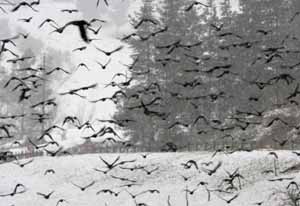
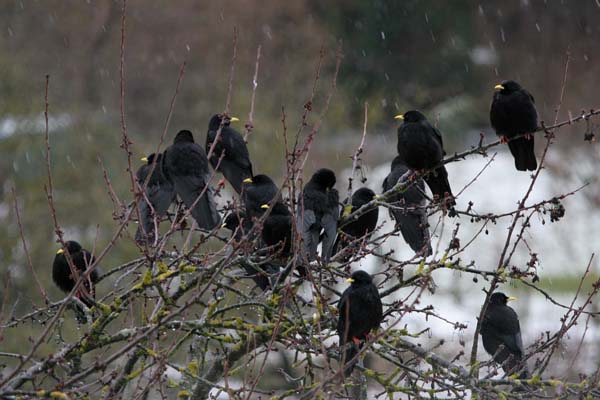

C-621 POTES > COSGAYA >
FUENTE DÉ
Grey Heron at Los Llanos. Two feet of snow around the lower cable car station (Teleférico) at
Fuente Dé which was deserted. Apparently open from the beginning
of March, the heavy, late winter snowfalls meant we couldn't
access the mountain area around the upper cable car station
for Snowfinch. Good views of a Middle Spotted Woodpecker feeding
along the bases of pines around the junction for the cable car
station, opposite the Parador. Jays calling. The mountain scenery
was invisible due to the white-out conditions.
HOTEL DEL OSO, COSGAYA
We had booked two nights at this very nice hotel (www.hoteldeloso.com) and by the time we had
arrived the snow increased and continued throughout the night.
According to the staff they had had severe weather since Christmas.
The immediate area was good for birds and the following were
noted from the balcony as we unpacked: Black-bellied Dipper
(2), Grey Wagtail, White Wagtail and Grey Heron on the
river below, Common Buzzard on a telegraph pole across the road,
Great Spotted Woodpecker by the tennis court/swimming pool area,
Redwing, Robin, Wren, Blackbird, Great Tit and Long-tailed Tit.
More Buzzards and Bullfinches (3 mm + f) just along the road.
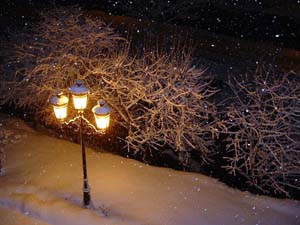
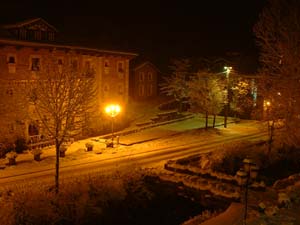

Friday 4
March 2005
Cosgaya
> Potes > La Hermida > Fuente Dé > Cosgaya, Picos
de Europa, Asturias/Cantabria.
Overcast with sleet & snow showers, eventually clearing after 1645h.
HOTEL
DEL OSO, COSGAYA, PARQUE NATURAL DE LOS PICOS DE EUROPA
Several inches of snow had fallen overnight. Had a look around the immediate
area until the snow ploughs had cleared the road. Marsh Tit
and Great Tit calling in the oak woodland around the small cemetery.
White Wagtail (2-3) around the hotel buildings. Red-billed Chough
heard calling overhead. Robins fairly tame. House Sparrow (6+).
Dipper flew overhead along the course of the Río Deva. Grey
Heron flew downstream. A pair of Black-bellied Dippers further
upstream. Wren. Great Spotted Woodpecker calling. Just across
the road a steep single track road leads up to the hamlet of
Treviño. Species noted here: Firecrest (2-3) watched at close
range on the edge of a small group of pines. Bullfinch (m) striping
the buds left exposed on snow-covered twigs. Jay calling. Red
Deer tip-toeing through the deep snow. Long-tailed Tit (2),
Great Tit, Blue Tit, Coal Tit, Common Buzzard (2), Carrion Crow
and Blackbird.
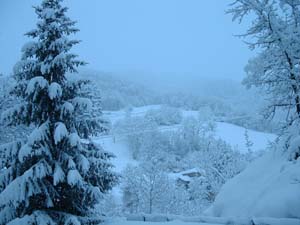
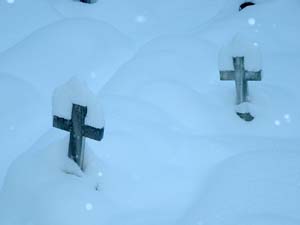
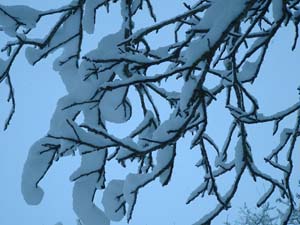
COSGAYA > LOS LLANOS
Bullfinch, Common Buzzard and Carrion Crow.
C-621 JUNCTION FOR BREZ
Raven, Great Spotted Woodpecker, Grey Heron, Robin and Blackbird.
TAMA
Red-billed Chough (6) overhead. Stonechat, Common Buzzard, Song Thrush, Blackbird,
Robin and House Sparrow all common.
POTES
Red-billed Chough (3) scavenging around the main car park in the town. Serin
singing. Robin. Song Thrush. Large group of Alpine Chough (c100)
on the east side of the village.
CASTRO CILLORIGO
Red-billed Chough (30+) over the valley below the village. Black Redstart and
Meadow Pipit feeding at the roadside. Common Buzzard (2-3).
Griffon Vulture overhead. Great Spotted Woodpecker.
ENTRANCE TO LA HERMIDA GORGE
(DESFILADERO DE LA HERMIDA)
43° 11' 53N 04° 35' 28W
Area around the rock pinnacle on the other side of the river (Río Deva) - there is just
enough room to park a car or two on the right hand side of the
road. Stopped here as it looked a likely spot for a wintering
Wallcreeper. Griffon Vultures (min 6) drifting in and out of
view over the ridges here. Blue Rock Thrush hopping around the
top of the pinnacle. Pair of Dippers and a Grey Wagtail on
the river below. Kestrel (1). Cirl Bunting calling. Many thrushes
passing east over the gorge. Small group of Alpine Accentors
(6-7) feeding along the roadside and rocky cuttings c300 metres
into the gorge. While scanning the sky for raptors a Wallcreeper
flew overhead, probably 40 metres above, from the area of the
rock pinnacle to the mountain above the road and out of view.
Another Alpine Accentor high up on the pinnacle. Also Goldfinch
and Chaffinch noted.
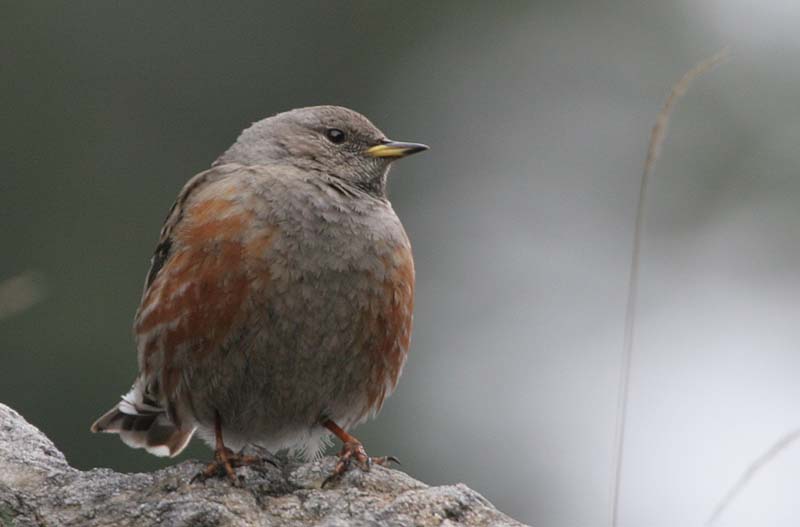
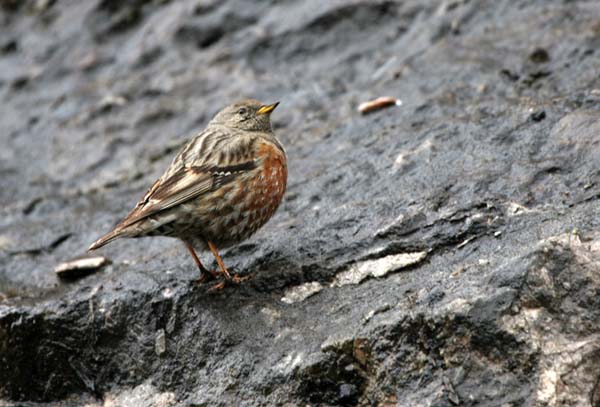
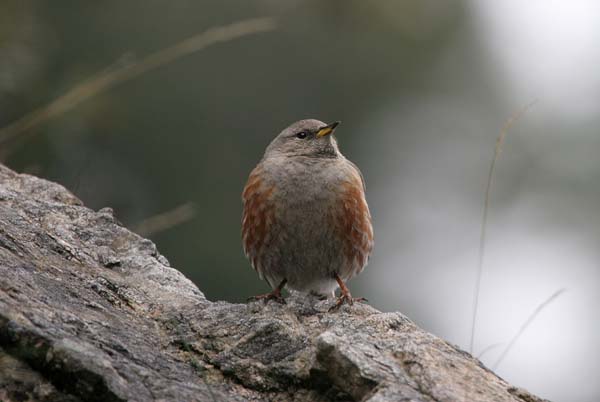
IGLESIA DE SANTA MARIA DE LEBEÑA
Pair of Rock Buntings foraging in the snow at this small church (€1 to see inside).
Dipper calling from the stream. Mistle Thrush (2), Blackbird,
Robin, Redwing, Meadow Pipit and Chaffinch. Again, Song Thrushes
were fairly abundant in this area.
LA HERMIDA GORGE AT Km-160.5
43° 13' 58N 04° 34' 44W
There is room to park a car under the high cliff on the right just before reaching
the bridge over the river. Spent some time searching for Wallcreeper
in this likely looking area. A Wallcreeper was found after 30
minutes or so on the sheer rock face across the river immediately
up from the bridge. Watched for some time as it moved closer
to the bridge before flying overhead to our side of the gorge
and onto the slope above the road. After 10 minutes feeding
here it flew back overhead across the river. Also in this area...
Blue Rock Thrush (m), Dipper (2), Red-billed Chough (45) plummeting
off the ridge
above, female Blackcap swallowing ivy berries, a few
Griffon Vultures perched conspicuously on the ledges and pinnacles,
Common Buzzard, Song Thrush, Robin, Blackcap and Great Tit.
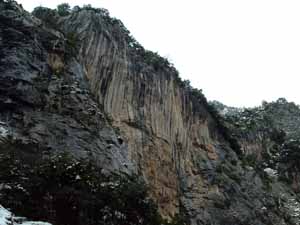
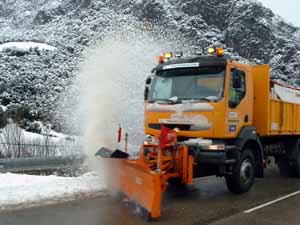
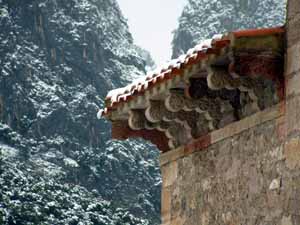
LA HERMIDA (VILLAGE)
Crag Martin (12) flying up and down the canalised stream flowing in to the Río
Deva. Great views from the footbridge as they passed underneath.
Chiffchaff flitting around a riverside garden. Two Griffon Vultures
circling over the village. Robin. Male Black Redstart one km west
of the village - showing large white wing patches.
C-621 at Km-161
Cormorant (2) in the river here.
CASTRO CILLORIGO
At least 170 Red-billed Chough now flocking around a field on the east side
of the village. By this time the snow showed clear evidence
of extensive foraging by the crows, deep into the snow to reach
bare ground.
FUENTE DÉ
After 1645h the snow stopped and the clouds cleared away to reveal the fantastic
mountain vistas of the area. Walked a few hundred metres up
the 4x4 trail through the forest before the snow became too
thick. Marsh Tit (3), Jay (3-4), Coal Tit, Great Tit, Blue Tit,
Nuthatch, Common Buzzard (2), and Raven. Several Chough and
Griffon Vultures visible way above around the top cable car
station.

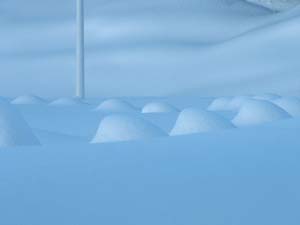

HOTEL DEL OSO, COSGAYA > TREVIÑO
Bullfinch (pr), Common Buzzard, Black-bellied Dipper, Long-tailed Tit, Great
Spotted Woodpecker, Dunnock, Song Thrush, Robin, Wren, Blackbird,
Wood Pigeon (8 o/h), Great Tit, and Blue Tit.
Saturday 5
March 2005
Cosgaya
> Bilbao > Vitoria-Gasteiz > Pamplona/Iruña > Foces de
la Sierra de Leyre > Tudela, Navarra
Cloudy, some drizzle in the Pyrenean foothills, heavy shower at the Foz de Lumbier,
clear skies around Tudela.
DRIVE
FROM THE PICOS TO NAVARRA
N-621: Alpine Accentor at the entrance to La Hermida gorge. Another two birds
at Km-158.5.
Stonechat at Km-159. Dipper heard calling at Km 160.5. Grey
Heron and Black Redstart at Remenes. Dipper in the river at
Estragüeña. Black Redstart at Km-173.
PUNTELLES
Stopped at the bridge over the river here. Two Short-toed Treecreepers singing.
Black Redstart (f) on the roof of a deserted building. Siskin
(f) feeding in an alder. Song Thrush passage overhead. Jay.
A-8/E-70 EASTWARDS
TOWARDS BILBAO
Common Buzzard at Km-267, Redwing (30) at Km-214. Common Buzzard at Km-182.5.
Great Egret (2) in a marshy field at Km-172. Common Buzzard
at Km-126.
E-05/N1 VITORIA-GASTEIZ
> PAMPLONA/IRUÑA
Cormorant (4) overhead at Km-15, Lapwing at Km-360, Starling sp. (c30) and Magpie
at Km-379. Mallard at Km-381. Red Kite at Km-382.
N-240A PAMPLONA/IRUÑA
Red Kite at Km-44, Red Kite and Griffon Vulture (4) at Km-35, Red Kite
at Km-27.5, Red Kite (2) and Griffon Vulture at Km-22.5.
A-15 PAMPLONA/IRUÑA
Griffon Vulture (3) on the outskirts of Pamplona at Km-111.
N-240 PAMPLONA
> JACA
The traffic was extremely slow and in fact the westbound carriageway was closed
due to hundreds of pilgrims walking along the Camino de Santiago.
Griffon Vulture (6) over Km-34. Crested Lark on the roadside
at the junction for Lumbier. Took the NA-178.
FOZ DE LUMBIER
Short walk from the car park to the entrance to the gorge and first tunnel.
Robin, Song Thrush, Blackbird and House Sparrow around the car
park and fields here. Many Griffon Vultures and Red-billed Choughs
in the sky over the area. Single Red Kite. Within a minute of
reaching the first viewpoint into the gorge (just before
the path enters the first old railway tunnel) I found a
Wallcreeper on the other side, feeding inches above the river.
Many Feral Pigeons here, mostly wild-type looking
birds present, with young calling from nests. After a few minutes
the Wallcreeper crossed over to the path-side of the river but
was out of view here where the gorge narrows suddenly. Griffon
Vulture (100+) in the area. Red-billed Chough (40-50). Raven
(6+). Long-tailed Tit, White Wagtail, Grey Wagtail, Goldfinch,
Blue Tit, Robin, and Blackbird present in scrub along the riverside.
White Stork (3) and Jackdaw (12) flew overhead. The second
tunnel is very dark half way through - take a torch. Sparrowhawk
(f) and a single Rock Sparrow back at the entrance. Walking
back towards the car park the fields on the right gradually
rise up to an impressive ridge with many Griffons drifting around.
On the lower slopes here a Golden Eagle was hunting not too
far above the ground. Another Red Kite over the village of Lumbier.
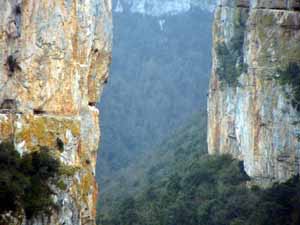
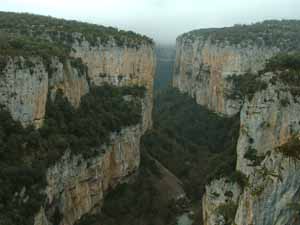
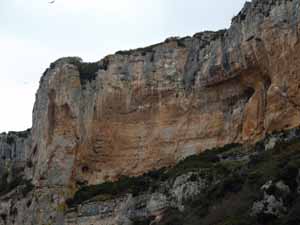
NA-178 LUMBIER
> PUERTO DE ISO
Red Kite and Crested Lark (4) at Km-3.5.
FOZ DE ARBAYUN
MIRADOR
Much less birds visible here although the weather and light had worsened considerably.
Nevertheless, the view here is outstanding. Griffon Vultures
repairing nests - clearly visible with good 'scope views. Raven
(4). Blackbird. Great Spotted Woodpecker calling.
A-127 SOUTHWARDS
FROM SANGÜESA/ZANGOZA
Griffon Vulture at Km-3. Red Kite (3) at Km-7. Fieldfare (12) at Km-85.5. Collared
Dove (3) in Castilisar. Kestrel at Km-70. Southern Grey Shrike
on a telegraph wire at Km-65. Red Kite (2) at Km-63.5.
EMBALSE DE
VALDELAFUENTE, SÁDABA
Impressive flock of c50 Lesser Short-toed Larks bouncing around here
beside the A-127 on the north side of the town. Marsh
Harrier (pr). Corn Bunting singing. Linnet (3).
SÁDABA
Stopped in the town here after spotting a wader in a dried out river/flood channel
as we drove over the bridge in the main street. It turned out
to be a Green Sandpiper with another two birds present
for company. Drowning the noise of the traffic was an impressive
roost of 150-200 House Sparrows forming in the conifers here.
Not to be outdone, a murmuration of at least 1000 Starlings
arrived to roost following the course of the A-127.
BACK ON THE
A-127 SOUTHWARDS TOWARDS EJEA
DE LOS CABALLEROS
Continuing out of town on the A-127 towards Ejea de los Caballeros, more and
more Starlings appeared to be following the road towards the
urban centre. Hundreds were flying in at great speed, hugging
the ground and occasionally rising to clear obstacles in their
path. Lapwing at Km-43. Another six right by the white line
at the roadside at Km-42.
A-125 EJEA
DE LOS CABALLEROS > TUDELA
Marsh Harrier at Km-35. Moorhen scrambling across the road at Km-31. Black Kite
(4) at Km-24. A nice sight of at least 23 Black Kites over a
marsh in the dusk light at Km-17.
Sunday 6
March 2005
Tudela
> Las Bardenas Reales > Laguna de Pitillas > Pamplona/Iruña
> Oieregi, Navarra
Mostly blue sky but bitterly cold with a fairly strong wind.
RÍO
EBRO, TUDELO
White Stork (6) in the river by the bridge on the northeast side of the town.
NA-134 TUDELA
> ARGUEDAS
Collared Dove at Km-5.5. Common Starling at the junction leading to the military
zone/bombing range near the petrol station, 1.5 kilometres south
of Arguedas. White Wagtail and Grey Heron in a ploughed field
here.
PARQUE NATURAL
DE LAS BARDENAS REALES
Surfaced road from the NA-134 leading to the military zone: Pintail (f) and
White Wagtail at a small pool. Marsh Harrier (3), Red Kite and
Mallard (4) at another reed-fringed pool. Turned left at the fork
at the gates and drove clockwise around the bombing/firing range.
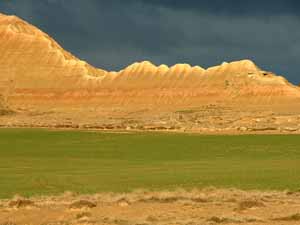

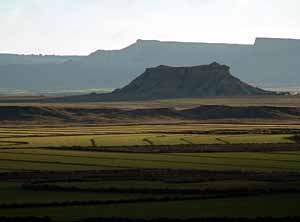
LAS BARDENAS
REALES AREA
AROUND THE ROCK FORMATION KNOWN AS CASTILDETIERRA
Red-legged Partridges calling. Corn Bunting singing. Red-billed Chough overhead.
Crested and Thekla Larks common. Lesser Short-toed Lark (3)
overhead. Jackdaw (20+). Several Tree Sparrows found in this
treeless landscape in the dry gorge/rambla behind the Castildetierra.
Magpie. House Sparrow. Serin. White Wagtail. Linnet (c60). Black-bellied
Sandgrouse calling. Another 16 Lesser Short-toed Larks flew
past. Sardinian Warbler calling from scrub. Black Redstart.
Stonechat. Great views of a male Dartford Warblers in sparse
knee-high scrub. Eventually a single Dupont's Lark was heard
singing high above and was picked up dropping back down to the ground
before it disappeared into the vegetation.
LAS BARDENAS
REALES CONTINUING
ON THE GRAVEL TRACKS
This whole area is worth the visit just for the surreal
landscapes alone. Stonechat (4), Red-billed
Chough (2) and a Marsh Harrier about four kilometres on from
Castildetierra. Area around a freshly sown area reclaimed for
cereal crops at 42° 13' 20N 01° 27' 54W:
Black-bellied Sandgrouse sitting in a field c200 metres from
the track along with 40 or so Lesser Short-toed Larks. Area
near the start of the eroded cliffs at 42° 12' 48N 01° 27' 25W: A
flock of 22 Black-bellied Sandgrouse flying around uttering
their strange gurgling calls. Griffon Vulture overhead. Lesser
Short-toed Lark (c70). Linnet (c30). White Wagtail. Area around
42° 11' 42N 01° 27' 20W: Pin-tailed
Sandgrouse (10) feeding in a newly sown cereal field c150
metres from the track. The double bands across the upper chest
of the female sandgrouse clearly visible. Area around 42° 11' 50N 01° 25' 50W:
Southern Grey Shrike (1), Calandra Lark (2), Serin (2), Rock
Sparrow (2), and a pair of Egyptian Vultures scoped sitting
conspicuously on one of the peaks. Lagoon at 42° 10' 09N 01° 26' 15W:
Pochard (25), Shoveler (70), Teal (c200), Crested Lark (c40),
Cormorant, a few Mallards and a Marsh Harrier. Another Marsh
Harrier a few kilometres further on along with another Southern
Grey Shrike and a Stonechat.


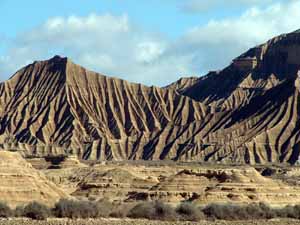
LAS BARDENAS
REALES BACK
ON THE TARMAC TOWARDS ARGUEDAS
42° 10' 28N 01° 32' 53W:
Southern Grey Shrike and Stonechat.
LAS BARDENAS
REALES JUNCTION
WITH NA-134
Around the cattle ranch at
least 600 Starlings, mostly Common but also good numbers of
Spotless in breeding plumage. With both the resident and the
winter visitors side-by-side the differences were clearly visible
by this time of year, particularly the green iridescence of
Common Starlings and the purple of the Spotless Starlings
distinctive in the early Spring sunshine. House Sparrow (100+).
White Wagtail (20+).
PITILLAS
Pair of White Storks circling
over the village and a single stork nest on the church tower.
Kestrel overhead.
LAGUNA DE PITILLAS
(www.lagunadepitillas.org)
Good numbers of wintering
waterfowl scattered over this large area. A visitor centre has
now been built here and, perched on an elevated position, provides
good views over much of the wetland. A 'scope is probably essential
though. A track leads off to a wooden hide further along. Coot
(700+). Black-necked Grebes (3-4) in breeding plumage just in
front of the visitor centre. Pintail (450). Pochard (100+).
Red-crested Pochard
(20+). Wigeon (150). Gadwall (22). Smaller numbers
of Wigeon and Teal. Marsh Harrier (6+). Greylag Goose (21).
Cormorant (10+). A few pairs of Grey Herons nesting on the ground
in the reedbeds - birds regularly carrying in twigs and small
branches. Southern Grey Shrike on the screening fence leading
to the small hide. Red Kite hunting over nearby farmland. Fieldfare
(10). Little Grebe (4 seen). Yellow-legged Gull. Skylarks (9)
feeding in a freshly sown cereal crop. Griffon Vulture overhead.
Stonechat. Crested Lark. Blackbird. Red-billed Chough (2) flew
past. White Wagtail. Magpie. Kestrel. Water Pipit flew by. Another
Water Pipit found feeding along a partially submerged boardwalk
on the edge of the lagoon. Bearded Reedlings had also been
seen by others earlier in the day.
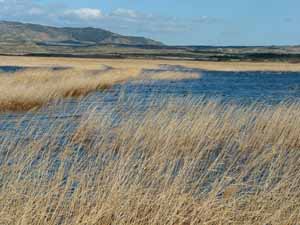
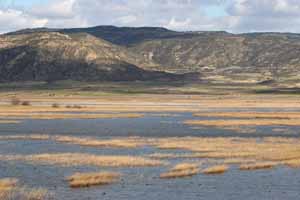

N-121 TAFALLA
> PAMPLONA/IRUÑA
Kestrel at Km-45.5. Collared
Doves common in Tafalla. Great Spotted Woodpecker over the road
at Km-28.5. Redwing at Km-25. Collared Dove (15) on wires at
Km-25. Kestrel on the outskirts of Pamplona.
OIEREGI, VALLE
DE ULZAMA
Area around the entrance to
the Parque Natural de Bértiz:
Redwings (c100) on the lawns around the visitor centre and picnic
tables. Also 50+ Chaffinches, Meadow Pipit (2), Goldfinch, Robin,
Blackbird, Blackcap (f) and Song Thrush. A pair of Firecrests
observed feeding within large clusters of mistletoe on the edge
of the botanic garden - the male singing at times. Dipper, Blackbird,
Grey Wagtail and Blackcap at the river.
Monday 7
March 2005
Oieregi
> Parque Natural de Bértiz > Reserva de la Biosfera de
Urdaibai, Euskadi
Partly cloudy & cool, more sunshine on the coast.
PARQUE
NATURAL DE BÉRTIZ
Spent several hours in this attractive area of Atlantic beech forest
with the intention of finding woodpeckers, particularly White-backed.
It was slightly disappointing but probably requires much more
exploration to reap its rewards. Nuthatch, Dipper, Chaffinch
and Wren singing at the entrance. Black Woodpecker (2
drumming birds heard), Great Spotted Woodpecker (2 birds heard
and seen), Short-toed Treecreepers singing, Nuthatch (12 heard
or seen), Jay (7 heard or seen), Blue Tit, Carrion Crow, Griffon
Vulture overhead, Common Buzzard (4), Great Tit, Crested Tit
(8), Marsh Tit (4), Lesser Spotted Woodpecker calling,
Raven calling, Coal Tit singing, Blackcap (f), Redwing. Several
hundred Chaffinches heading north over the hills along with
many birds resting in the canopy and feeding on beech mast on
the ground. Red Squirrel and Wild Boar (2).
N-121A TO IRUN
Raven at Km-52, Cormorant
at Km-58, Crag Martin at Km-73.5.
A-8/E-70 IRUN > DONOSTIA-SAN
SEBASTIAN > BILBAO
Common Buzzard at Km-45 & Common
Buzzard at Murueta.
RESERVA DE
LA BIOSFERA DE URDAIBAI: SAN KRISTOBAL AREA
Walked to the hide over the
railway off the BI-635: Cetti's Warbler singing in a small patch
of phragmites reed. Oystercatcher (3), Curlew (6), Red-breasted
Merganser (f), Shelduck (1), Little Egret (1), White Stork
(1), Cormorant (8), Mallard, Grey Heron, Yellow-legged Gull,
Lesser Black-backed Gull, and Black-headed Gull. This area was
disappointing but migration periods are probably better.
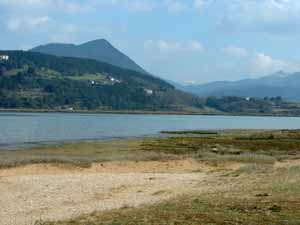


RESERVA DE
LA BIOSFERA DE URDAIBAI: BERMEO
Just after Mundaka a parking area overlooks the mouth of the estuary, the harbour
at Bermeo and out to sea from an elevated position. A few
Gannets offshore.
Several Shag around the harbour and offshore. Masses of Yellow-legged
Gulls around Isla de Izardo. Purple Sandpiper found
with a dozen Turnstone on a rocky area of the coast below this
lookout point. Also Grey Wagtail, White Wagtail, Meadow Pipit
and Robin here.
DRIVE BACK ON THE BI-635 TO
BILBAO/BILBO
AIRPORT
A few Crested Larks noted along the roadside.
